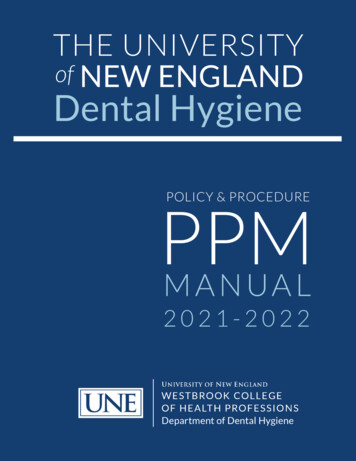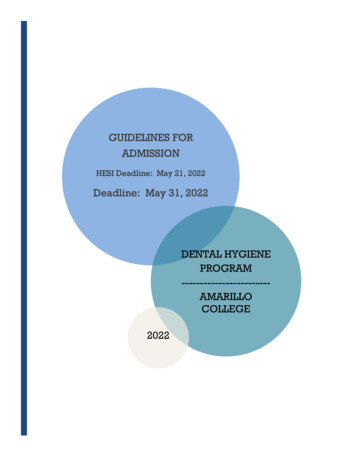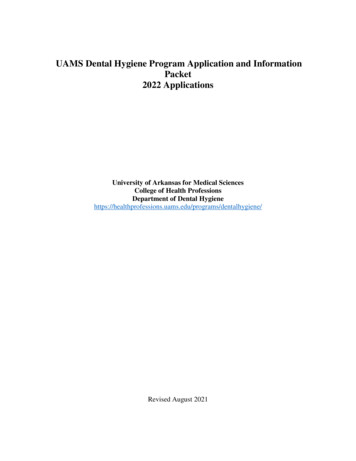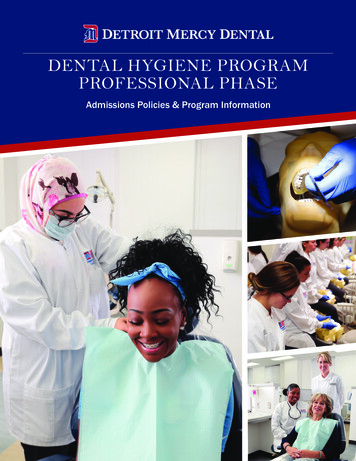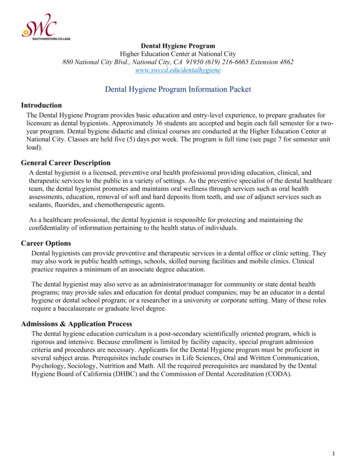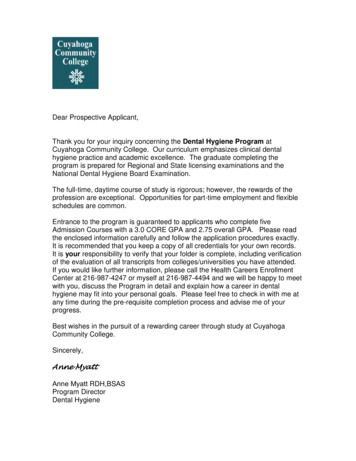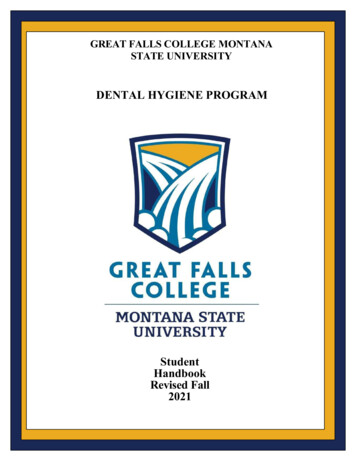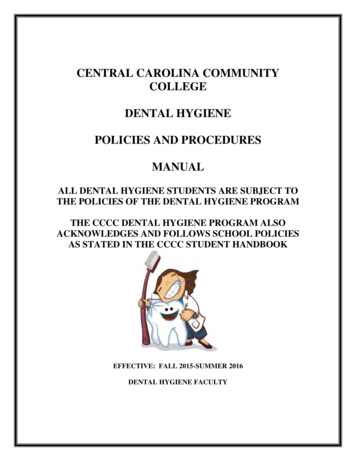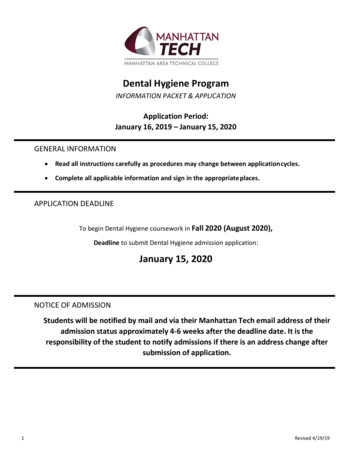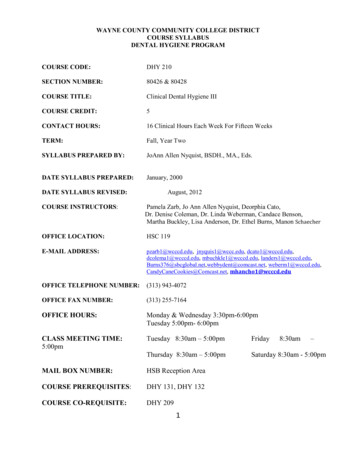
Transcription
WAYNE COUNTY COMMUNITY COLLEGE DISTRICTCOURSE SYLLABUSDENTAL HYGIENE PROGRAMCOURSE CODE:DHY 210SECTION NUMBER:80426 & 80428COURSE TITLE:Clinical Dental Hygiene IIICOURSE CREDIT:5CONTACT HOURS:16 Clinical Hours Each Week For Fifteen WeeksTERM:Fall, Year TwoSYLLABUS PREPARED BY:JoAnn Allen Nyquist, BSDH., MA., Eds.DATE SYLLABUS PREPARED:January, 2000DATE SYLLABUS REVISED:August, 2012COURSE INSTRUCTORS:Pamela Zarb, Jo Ann Allen Nyquist, Deorphia Cato,Dr. Denise Coleman, Dr. Linda Weberman, Candace Benson,Martha Buckley, Lisa Anderson, Dr. Ethel Burns, Manon SchaecherOFFICE LOCATION:HSC 119E-MAIL ADDRESS:pzarb1@wcccd.edu, jnyquis1@wccc.edu, dcato1@wcccd.edu,dcolema1@wcccd.edu, mbuchkle1@wcccd.edu, t@comcast.net, weberm1@wcccd.edu,CandyCaneCookies@Comcast.net, mhancho1@wcccd.eduOFFICE TELEPHONE NUMBER:(313) 943-4072OFFICE FAX NUMBER:(313) 255-7164OFFICE HOURS:Monday & Wednesday 3:30pm-6:00pmTuesday 5:00pm- 6:00pmCLASS MEETING TIME:5:00pmTuesday 8:30am – 5:00pmFridayThursday 8:30am – 5:00pmSaturday 8:30am - 5:00pmMAIL BOX NUMBER:HSB Reception AreaCOURSE PREREQUISITES:DHY 131, DHY 132COURSE CO-REQUISITE:DHY 20918:30am–
Course Description:The delivery of comprehensive care is accomplished through adherence to the process of care:assessment of patient needs, formulation of a dental hygiene diagnosis, planning for theprevention and treatment of oral disease, implementation of various dental hygiene interventions(services) and evaluation of both the patient and practitioner efforts and oral health outcomes.Clinical dental hygiene focuses on developing the cognitive, affective and psychomotor skillsnecessary for the delivery of preventive, educational and therapeutic services to the public.Clinical practice is provided in collaboration with the clinical dental hygiene faculty through anassessment of patient needs, planning for treatment and disease control. Treatment includesimplementation of various clinical dental hygiene services and an evaluation of treatmenteffectiveness based on the patient and practitioners efforts. Sequential courses are designed toincrease the student’s speed and ability. Assessment of student progress in attaining programand clinical competency is ongoing.COURSE GOALS:Clinical dental hygiene experience provides preventive and therapeutic care according to theprocess of care; assessment, dental hygiene diagnosis, planning, implementation and evaluation.This requires critical thinking and evidenced-based decision making skills that guide theprovision of dental hygiene care within a focused scope of practice. As primary provider, thedental hygiene student integrates preventive, educational and therapeutic care in treating thepatient.1.Apply a professional code of ethics in all endeavors.2.Adhere to state and federal laws, recommendations and regulations in the provision ofdental hygiene care.3.Provide dental hygiene care to promote patient health and wellness using critical thinkingand problem solving in the provision of evidence based practice to include patients at alllevels of physical, mental social/emotional, selected medical conditions that includes theelderly and medically compromised.4.Assume responsibility for dental hygiene actions and care based on accepted scientifictheories and research as well as the accepted standard of care.5.Provide accurate, consistent, and complete documentation for assessment, diagnosis,planning, implementation, and evaluation of dental hygiene services.2
6.Provide care to all patients using an individualized approach that is humane, empathetic,and caring.7.Establish a collaborative relationship and identify communication issues (verbal andnonverbal) with the patient in the planned care to include etiology, prognosis, andtreatment alternative/resources.8.Initiate and make appropriate referrals to other healthcare professional for all clinicalpatients .9.Obtain the patient’s informed consent based on a thorough care presentation.10.Apply the process of care to preventive and therapeutic oral health management to adiverse patient population.11.Assess and analyze objective and subjective patient findings to formulate an evidencedbased, patient-centered dental hygiene diagnosis.12.Plan, implement and evaluate intervention strategies that will promote and maintain oralhealth including oral self care behaviors.13.Demonstrate knowledge of and skill in applying dental hygiene methodology of care thatincludes the proper use of armamentarium and equipment for providing dental care to allpatients including all ASA levels.14.Apply the principles of professional and ethical behaviour.15.Identify the dental hygienists role and resolve potential medical emergencies.Behavioral ObjectivesUpon completion of DHY 210 Clinical Dental Hygiene III, the student will be competent in:A. Prevention of disease transmission1. Asepsis protocol of recommended clinical guidelines for infection and hazardmanagement prior, during and after the provision of dental hygiene services.2. Management of individuals with bloodborne infectious diseases.3. Post exposure guidelines as defined by the Centers for Disease Control and Prevention.4. Selection and utilization of effective methods of instrument and dental unitsterilization/disinfection.5. Valuing the dental hygienist’s role in preventing disease transmission.B. Patient/operator positioning1. Positioning self and patient to maximize accessibility and visibility to the field ofoperation.3
2. Selecting operator positioning strategies to prevent or lessen the risk of injury to selfand/or patient during implementation of dental hygiene care.3. Valuing the need for effective and safe patient/operator positioning.C. Time and motion management1. Selecting time and motion patterns for safe and efficient implementation of dentalhygiene care.2. Valuing the need for efficient time and motion management.D. Prevention and/or management of emergency situations1. Developing a management plan for medical emergencies2. Applying current methods for prevention of emergencies3. Assessing patient’s need for emergency care4. Implementing basic life support methods consistent with American Heart AssociationStandards.5. Valuing maintaining skills in preventing and managing emergencies6. Valuing the dental hygienist’s role in preventing and managing emergencies.E. Comprehensive patient assessment1. Obtaining and recording a comprehensive medical, social, dental and nutrition healthhistory.2. Recognizing conditions that necessitate special consideration prior to or duringtreatment.3. Obtaining, interpreting and monitoring vital signs according to American HeartAssociation guidelines.4. Performing and documenting an extra- and intra-oral examination that includes softand hard tissue of the head, neck and oral cavity.5. Performing and documenting an examination of the dentition that includes dentalcharting, occlusion and assessment of hard and soft deposits.6. Performing and documenting an examination of the periodontium that includesgingival assessment, recession, bleeding upon probing, sulci and/or pocketmeasurements, clinical attachment level, furcation involvement, tooth mobility,fremitus, mucogingival conditions and radiographic findings.7. Evaluating patient risk factors for oral diseases.8. Discriminating pertinent and significant assessment findings from those that are notsignificant or within a range of normal.9. Assessing the need for exposing intraoral and/or extraoral radiographs to support theclinical examination.10. Exposing, developing, interpreting and evaluating intraoral and extraoral dentalradiographs.11. Assessing the need for exposing, developing and implementing intraoralphotography.12. Employing radiation safety principles in procedures requiring exposure to ionizingradiation.4
13. Performing and utilizing supplemental screening tools to support assessmentstrategies such as periodontal screening, alginate impressions and study models,indices, vitality sting.14. Assessing for patient’s oral health needs, beliefs, knowledge, skills and self carepractices.15. Valuing the need for consistently performing patient assessment at professionallyaccepted standards of care.F. Diagnosis and planning of dental hygiene care1. Analyzing patient’s needs for preventive, educational, and therapeutic dental hygieneservices.2. Synthesizing patient assessment findings and risk factors in formulating a patientcentered dental hygiene treatment plan and case presentation.3. Formulating a dental hygiene diagnosis from comprehensive assessment findings orevidence.4. Proposing measurable patient outcome goals for oral health.5. Identifying factors contributing to the patient’s preventive, educational and/ortherapeutic oral health needs.6. Selecting dental hygiene intervention strategies that will guide the patient to achievingpatient centered oral health outcomes that include oral and systemic health educationstrategies.7. Appointment planning and sequencing of dental hygiene care to meet the patient’s oralhealth goals.8. Obtaining informed consent by discussing with the patient his/her oral health findings,goals and treatment strategies.9. Value the importance of patient centered care and concepts of health promotion.G. Principles and methods of dental hygiene intervention1. Implementing dental hygiene strategies and services that address the factorscontributing to the patient’s preventive, educational and/or therapeutic oral healthneeds.2. Implementing cognitive, psychomotor and affective strategies to manage barriers tooral self care.3. Performing nutritional and tobacco cessation counseling for oral health management.4. Performing initial and supportive periodontal therapies.5. Implementing non-surgical therapeutic periodontal debridement procedures supportiveof the patient’s oral health condition.6. Applying the principles of instrumentation that include grasp, fulcrum, adaptation,angulation, activation/stroke and lateral pressure to assure complete debridement.7. Applying the principles of instrument design that include shank, handle, workingend/ blade to support instrument selection for maximum effectiveness, safety andefficiency in debridement procedures.8. Applying principles of therapeutic ultrasonic periodontal debridement.9. Maintaining instrument sharpness.5
10. Applying pain and anxiety management strategies that include application of topicalanesthetics, application of hard tissue topical desensitizing agents, administering orassisting in the administration of block and infiltration anesthesia, and administeringor monitoring of nitrous oxide/oxygen analgesia.11. Applying preventive and therapeutic topical agents for disease management thatinclude fluoride, antimicrobial agents and local delivery/controlled released agents.12. Applying selective coronal polishing procedures that include engine driven polishing,air-powder polishing and selection of polishing agent.13. Performing and evaluating the placement of pit and fissure sealants.14. Valuing the need for consistently performing preventive, educational and/ortherapeutic dental hygiene services at professionally accepted standards of care.H. Principles and methods of evaluating outcomes of dental hygiene care.1. Evaluating and documenting the results of preventive and/or therapeutic dentalhygiene interventions in meeting the proposed treatment plan goals2. Recommending a re-care schedule for continued supportive care.3. Recommending referral for additional assessment and/or treatment.4. Valuing the importance of evaluation in monitoring patient oral health.5. Assessing overall patient satisfaction with care provided.I. Monitoring and Record Keeping1. Applying the principles for maintaining comprehensive and accurate records of allinformation and services offered to and provided to the patient.2. Documenting additional dental care needed by the patient.3. Value the need for maintenance of thorough and accurate records.J. Professional Ethics1. Applying the principles of professional and ethical behavior when providing patientcare.2. Self- assessing ability to perform dental hygiene services at a high standard of care.3. Valuing patient confidentiality and patient rights according to HIPAA guidelines.4. Valuing the patient’s right to dental hygiene care consistently provided at acceptableStandards.COURSE OBJECTIVES:DENTAL HYGIENE COMPETENCIESUpon completion of DHY 210, the student will be able to:1.2.Select treatment, supervise educational sessions,and present a plan to the patient.7.1, 7.2, 7.3Collect data, record and assess a comprehensivemedical, dental history and social history and monitorvital signs.6.1, 6.2, 6.3, 6.46
3.Perform and record:a.b.c.d.4.6.5, 6.6, 6.8extra and intraoral examinationexamination and charting of the periodontiumgingival assessmentdental chartingPerform dental hygiene procedures with maximumefficiency of time and motion.8.1Perform clinical and radiographic assessment of the periodontiumand dention.6.76.Perform an assessment of occlusion.6.6, 6.87.Assess the need for, expose, develop, evaluate andinterpret intraoral radiographs.6.78.Perform scaling and root planning procedures.8.1, 8.2, 8.3, 8.49.Perform extrinsic stain removal procedures.8.1, 8.2, 8.310.Assess the need for and perform therapeutic hand andultrasonic periodontal debridement therapies.6.8, 6.9, 6.10,11.Expose and implement intra oral photography.6.712.Formulate a dental hygiene diagnosis and supportive dental hygienetreatment plan.7.1, 7.2, 7.3Assess, plan, implement and evaluate a dental hygienetreatment plan for the prevention and or treatment of oral diseases.7.1, 7.2, 7.3Assess the need for and apply adjunctive topicchemotherapeutic and controlled released agents.8.2, 8.3, 8.4Assess the need for and perform initial and supportiveperiodontal therapies.8.2, 8.3, 8.417.Assess the need for and apply pain and anxiety managementstrategies.Take impressions for study models.8.48.418.Pour and trim study models.8.45.13.14.15.16.7
19.Place and remove the rubber dam.8.420.Assess the need for and plan professional topical fluoride and/orself applied. Apply professional topical fluoride.8.421.Assess the need for and apply pit and fissure sealants to selected areas.8.422.Apply desensitizing agents.8.423.Apply principles of nutritional and tobacco cessation counselingto the management of oral health.6.9, 8.2, 8.4Assess the need and apply topical and local anesthetic to oralmucous membranes.8.3, 8.425.Assess, plan and perform patient oral self care education.4.1, 4.226.Perform margination procedure when indicated.8.427.Conduct a complete dietary analysis on one clinical patient.6.9, 8.428.Conduct a tobacco cessation study on one clinical patient.8.2, 8.429.Asses the need for and perform pulp vitality testing.8.430.Perform 1 complete occlusal screenings.8.431.Evaluate clinical and educational services.9.1, 9.232.Perform care and maintenance of procedures fordental implants.8.2Apply standards of precautions for the prevention ofdisease transmission.8.1Follow all state and federal regulatory requirementswhen rendering patient care.8.1, 8.435.Apply principles of comprehensive record keeping.2.436.Apply principles of professional and ethical behavior.1.1, 1.2, 1.3, 1.424.33.34.8
37.Apply principles of evidence-based decision making.7.1, 7.2, 9.138.Demonstrate critical thinking and problem solving skillswhen providing patient care.7.1, 7.2, 9.1Demonstrate professional communication skills in all aspectsof patient care.2.439.40.Demonstrate concern and understanding of a variety of patientneeds based on overall health, oral health, cultural, social andeconomic circumstances.6.10, 7.2, 7.3, 8.2,9.1, 9.2Required Textbooks:Anderson, K., Anderson, L., Mosby’s Pocket Dictionary of Medicine, Nursing and Allied Health,Mosby, Fifth Edition, 2006.CES-CAM Clinical Evaluation Manual, Dept. of Dental Hygiene, Wayne County CommunityCollege District, 2010.Clinical Procedural Manual, Dept. of Dental Hygiene, Wayne County Community College District,2010.Cooper, Mary Danusis, Weichmann, Laurie, Essentials of Dental Hygiene, First Edition,Pearson/Prentice Hall, 2005.Infection Control Manual, Dept. of Dental Hygiene, Wayne County Community College District.2010.Nield, Jill S., Patient Assessment Tutorial: A Step By Step Guide for the Dental Hygienist, 1stEdition, 2010.The Chairside Instructor, American Dental Association, 1-800-947-4746.Wilkins, E., Clinical Practice of the Dental Hygienist, 10th Edition, Williams & Wilkins, 2009.Wynn, Meiller, Crossley, Drug Information Handbook for Dentistry, 10th Edition Lexi-Comp., 2005.Reference Textbooks:Daniels, S. Harfst, S., Mosby’s Dental Hygiene Concepts, Cases and Competencies, 2nd Edition,Elsevier, 2008.9
Langlais, Robert, Miller, Craig S., Color Atlas of Common Oral Diseases, Lea & Febiger, 2003.Wood., Norman K., Review of Diagnosis, Oral Medicine, Radiology and Treatment Planning, 4thEdition, C. V. Mosby Co., 1999.Required Additional Materials:Students will utilize instruments, materials, lab coats, uniforms and supplies purchased in DHY 120.Since students are responsible for their own instruments, etc., any lost or broken materials must bepurchased by the student at their own expense through Sullivan ScheinCompany.Teaching Methods:Individualized clinical instruction and observation between clinical faculty and student focusing ondemonstration, instruction and guidance.Expected Student Behavior:The student must adhere to all of the procedures and behavior outlined in the clinical proceduralmanual, infection control manual and the clinical evaluation manual. Thorough reading andcontinual referral to the above manuals is necessary for the dental hygiene student to insurecompliance with the expected student behavior.Clinic Attire Policy:During all clinic sessions with patients, students will be dressed appropriately abiding by theProfessional Dress Code as outlined in the Wayne County Community College District DentalHygiene Program Infection Control Manual. Standard Precaution Guidelines will be strictlyenforced.Flexibility Statement:Assignment/course calendar may be changed in response to institutional, weather, or problems thatmay arise that are beyond control. In the event of change, the instructor will notify students andclearly communicate changes.Professionalism StatementWhile enrolled in this course, students in the Wayne County Community College District DentalHygiene Program are expected to adhere to the professional conduct outlined by the AmericanDental Hygiene Code of Ethics and Wayne County Community College District Dental Hygiene10
Program Student Information Booklet. Failure to maintain professional conduct will result in aconference with the course instructor and the program director. Disciplinary action will be taken asoutlined in the Student Handbook.Students are expected to follow specific guidelines sets by the Wayne County Community CollegeDistrict dental programs in the use of “Universal Precautions” while in the clinical areas. Thesestandards are explained and demonstrated in DHY 101 and DHY 120 and can be found in theclinical manual. In addition students must adhere to student policies in the clinic manual andprogram handbook.Course Policies:1.Attendance:The nature of the Dental Hygiene Program necessitates the student’s regular attendance, sothat he/she may obtain maximum benefit from the courses, and ultimately from the programof study. While urging regular attendance, the Dental Hygiene Program desires to allowstudents an opportunity to develop a sense of personal responsibility towards their studiesand development as a professional.Attendance is mandatory; more than (3) three absences will result in a failing course grade.Students are required to sign in and out each clinic session. Students who are tardy fiveminutes or more will have their final course grade lowered by 1% for each tardy appearance.One 8 hour session is considered one absence. One 4 hour session is considered one halfsession.Notification of any clinic, lab, classroom and/or rotation absence must be made to the coursefaculty, as well as the Program Director prior to the scheduled session. In the event that youare scheduled for an external rotation session, you must also contact that rotation site toinform them of your absence. Expecting a classmate to relay such notification on your behalfis not acceptable and will be considered an unexcused absence.Make-up assessments will be determined by the course instructor.In case of illness or unavoidable absence notify the Program Director and ClinicalCoordinator by 8:00am. You are responsible to insure cancellation of your own patient. Forextended illnesses make-up will be at the discretion of the Program Director.2.Clinical Hours:Participation is required in all assigned on-site and off-site clinical sessions. Students areexpected to be present in their clinical session fifteen minutes prior to the scheduled clinicalsession to prepare for their patient. Students are to dismiss their patients thirty minutes priorto the cessation of clinic to disinfect and sanitize their unit and complete their clinical11
treatment records. Students are expected to sign in and out each clinical session. Studentsare also expected to stay on campus until the end of each clinical session. The clinicalassistants are to be present at least 15 minutes prior to the clinical session and remain 15minutes after the end of each clinical session.3.Clinical Requirements:All criteria and objectives for each clinical skill can be found in the CES CAM Manual.Clinical skill assessments will be distributed to students.4.Minimum Clinical Requirements:It is suggested that at the completion of this course students should complete the followingminimum requirements:2Children2Class I’s1Class II’sStudents should complete a minimum of 5 patients by the end of the summer semester.Complete all clinical skill assessments.5.Off-Site Clinical Assignments:Each student will be assigned to The Chass Health Center, Detroit, during the semester. Thestudent will complete the following procedures on patients at this rotation site.Medical/Dental HistoryIntra/Extra Oral ExaminationDental ChartingPatient ntsAll procedures completed will be evaluated by the Supervising Dentist or Dental Hygienist.More detailed information concerning extramural rotation assignments are outlined in theExtramural Manual and will be reviewed in DHY 210. The student is required to submit anevaluation of each off-site assignment. The off-site dentist/dental hygienist will submit a formalevaluation on each student.12
6.Course Assessment:The student must receive an average of 75 or above in this course in order to obtain apassing grade.93 - 100 A86 - 92 B75 – 85 C69 – 74 D0 – 68 EAssessment Measures: Attendance Clinical observation by faculty Daily evaluations by faculty on clinical competencies Clinical reflection logs (self evaluation) Practical examination Primary Trait Assessment Tools Course Assessment Portfolio Patient surveys Chart AuditEvaluation Criteria (Indicated with “R” if the criterion is required for the course or “NR”if the criterion is nor required for the course.RRRNRNRRRNRNRNRNRNRNRRRAttendanceClass DiscussionPapersPortfolioProjectsReportsClinical WorkQuizzesTestsMidtermFinal ExamHomeworkPresentationsPerformancesOtherStudents are required to submit weekly clinical self-reflection tools for self-assessment. Thisself-assessment document must be submitted to your faculty advisor weekly and minimally atmid-term (7th week) and final (14th) week.13
If a student receives a grade of “D” or below the student will not be permitted to register forDHY 220. The student must schedule a conference with the course instructor to discusspromotion within the dental hygiene program.Please refer to the evaluation manual for grading procedures for each clinical skill in DHY 210.A computerized personal grading sheet will be distributed at least once a month to alert studentsas to their clinical progress. Any questions pertaining to the evaluation sheet should be answeredby the clinical coordinator.Attached is the form used for clinical evaluations for DHY 210. Please review the clinicalevaluation manual for further pertinent information.7.Clinical RequirementsEach student will be responsible for completing clinical requirements as outlined bygraduation.(A)Prophylaxis RequirementsClass C - 4Class I - 4Class II - 13Class III 6Maintenance Class - 3AAP Case Type Requirements: Type I – 9Type II – 3Type III – 2Type IV – 4 teeth, anterior or posteriorStudents will be responsible for entering the patient’s disease progression status of category Ithrough VIII on the bottom of clinical grade forms and enter in the patients treatment record.The recommended number of appointments for each classification are:Class CClass IClass IIClass IIIClass IV1 appointment1 appointment3 appointments3 - 4 appointments4 - 5 appointments14
(B)RadiologyThe radiographic requirement is as follows:The student must present a complete updated set of radiographs on each clinicalpatient prior to receiving a restorative charting evaluation.Complete at least 13 complete mouth surveys exposed, developed, and evaluatedfor technique and pathology by the student.Bitewing Surveys - minimum of six bitewing surveys. Bitewing surveys aretaken as required by the Supervising Dentist and upon recommendation. Twomixed dentition surveys.One Radiology Interpretive Session with the Supervising Dentist.One Radiology Proficiency Session with one clinical faculty member.(C)Restorative ChartingsRestorative chartings are to be completed on each patient and evaluated by theSupervising Dentist.(D)Periodontal ChartingsPeriodontal chartings are performed on all Class III patients. Pocket depthreadings are recorded on all other patients. Additional periodontal chartings arecompleted on all AAP type II or more. The assignment of the periodontalcharting will be done after x-rays have been taken and the supervising dentist hasdetermined the AAP case type. The student records a complete initial periodontalcharting prior to scaling and revises the charting prior to the final check time.(E)Treatment PlanningA treatment plan is completed on all patients after all assessment data has beenobtained. The treatment plan is evaluated by clinical faculty.(F)Fluoride TreatmentPerformed on all patients unless contraindicated or refused.(G)Study ModelsFive acceptable study models taken, poured and trimmed. Study models are15
evaluated by the supervising dentist and the clinical coordinator.(H)SealantsTwenty-eight evaluated by the Supervising Dentist.(I)Rubber DamPlacement and removal of rubber dam on two separate quadrants. One anteriorand one posterior.(J)Instrument Competencies(i)(ii)(iii)(iv)(v)(vi)(K)Gracey curetsSickle scalersExplorerPeriodontal probeUniversal curettesUltrasonic scalerInfection Control CompetencyOne each semester.(L)Pulp Vitality TestingPerform on one Selected Patient.(M)Clinical AssistantTwo clinical assistants will be scheduled as the clinical assistant each clinicalsession.(N)Subgingival IrrigationPerform on two separate quadrants.(O)Subgingival Placement of Chemotherapeutic AgentsPlace chemotherapeutic agent on a minimum of two sites.(P)Occlusal ScreeningsPerform one occlusal screening.16
(Q)Local Anesthesia: students will perform the following injections on clinicalpatients – 19 total2 Inferior Alveolar nerve blocks2 Long Buccal2 Anterior, 2 Middle, 2 Posterior Superior Alveolar Nerve Blocks2 Mental2 Palatal and Nasopalatine3 Infiltrations2 Greater Palatine1 Nitrous Oxide Sedation Competency(R)Tobacco Cessation1 completed patient(S)During the semester, students will be given information regarding two clinicalpatient procedures that are due as part of the clinical requirements for graduation.These involve a Case Documentation report and a Nutrition Case Study. Furtherinformation will be presented in class. The Nutrition Case Study is due by theend of this semester and the Case Documentation is due by the end of DHY 220.(T)Complete all extra-mural clinical assignments and submit evaluations.(U)Teeth Bleaching. Minimum of two fabrications of bleaching trays.(V)DesensitizationTwo separate teeth.(W)Topical AnesthesiaApplied to 1 quadrant.(X)Ultrasonic ScalingTwo quadrants on two separate patients.(Y)Instrument SharpeningDemonstration of all scaling/perio debridement instruments.(Z)Medical Emergency Competency.(AA) Complete all extra-mural clinical assignments and submit evaluations.17
(BB) Complete all 20 Service Learning Experiences and Submit Journal Entriesand all Evaluations.(CC) Edentulous competency Mounting 1 set of edentulous radiographs Cleaning of partial denture Cleaning of full denture(DD) 1 Case Presentation(EE)1 Case Documentation(FF)1 Nutritional Counseling StudyRetesting is required for any student who does not meet the acceptable standard for thecompetency tested. Please see the individual competencies for criteria.Total DHY 210 Course Grade8.(1)Completed clinical evaluations.(2)Auxiliary procedures completed.(3)Extra Mural evaluations and assignments completed.(4)Infection Control Competency(5)Instrumentation Competencies(6)Medical Emergency CompetencyPolicy Regarding Incomplete WorkStudents will be allowed to carry over incomplete clinical requirements to DHY 220.However, all clinical incomplete requirements must be completed in order to graduatefrom the program. The DHY 210 clinical grade will be based on only completedrequirements. Students must receive 75% (C grade or above) in both DHY 209 andDHY 210 to advance to DHY 219 and DHY 220.If a student receives a grade of “D” or below the student will not be permitted to registerfor DHY 220 and will be dismissed from the dental hygiene program. The student mustsch
1 WAYNE COUNTY COMMUNITY COLLEGE DISTRICT COURSE SYLLABUS DENTAL HYGIENE PROGRAM COURSE CODE: DHY 210 SECTION NUMBER: 80426 & 80428 COURSE TITLE: Clinical Dental Hygiene III COURSE CREDIT: 5 CONTACT HOURS: 16 Clinical Hours Each Week For Fifteen Weeks TERM: Fall, Year Two SYLLABUS PREPARED BY: JoAnn Allen Nyquist, BSDH., MA., Eds. DATE SYLLABUS PREPARED: January, 2000
